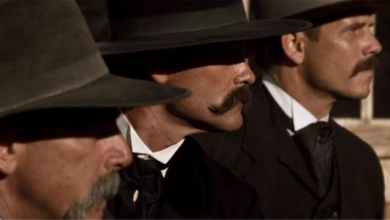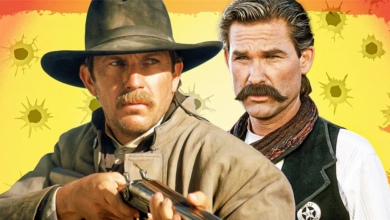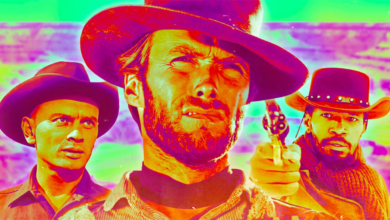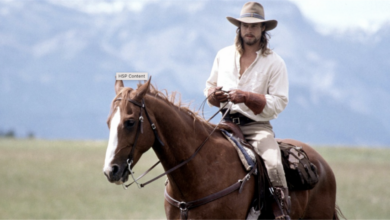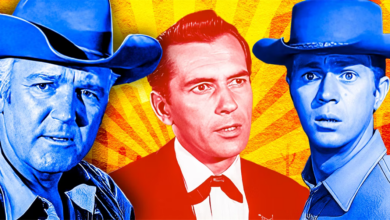11 Historically Inaccurate Tropes Western Movies Always Get Wrong

The Wild West wasn’t exactly full of quick-draw shootouts, clean-shaven cowboys, and tumbleweed. Historically inaccurate Western movie tropes change how we view the bygone era, from erasing certain groups to promoting a fictional view of the frontier that distorts the truth. Most frontier towns followed strict gun control laws, for example, which banned open carrying. And men avoided duels on main street – instead, it was easier to ambush your enemies outside of town.
The list of what Western movies get wrong includes some relatively harmless errors, like the abundance of tumbleweed – which probably upsets botanists who know that tumbleweed wasn’t even growing around early western towns when they were first established. But some tropes promote harmful stereotypes about Native Americans and Mexicans by treating them as evil villains or “noble savages.” During the heyday of the Western in the 1950s and 1960s, Hollywood rewrote history by casting white actors to play Black frontiersmen, or simply leaving out people of color completely.
In the name of telling a good story, Western movies keep repeating the same historically inaccurate tropes.
Standoffs And Quick-Draw Shootouts Are A Common Occurrence

The Trope: A stranger comes to town, and within minutes someone challenges him to a quick-draw. In Westerns, people seem to spend most of their time in gun fights, which certainly adds to the drama – even if it isn’t historically accurate.
Why Is It Inaccurate? Almost everything about duels in Westerns is historically inaccurate, even down to the name “gunslinger,” which first appeared in a movie . Instead, those renowned for their skills were often called “shootists,” and they rarely squared up for a duel.
Standoffs were uncommon, and men certainly didn’t wear low-slung hip holsters, which Hollywood invented. In fact, most in the Old West avoided pistols completely, preferring shotguns and rifles.
And the “quick draw” duel in the street at high noon? Those were almost nonexistent in the real Old West. Only two appear in historical sources: Wild Bill Hickok took out Davis Tutt in Springfield, Missouri, and Jim Courtright perished in his duel with Luke Short.
Notable Offenders: High Noon; The Good, The Bad And The Ugly; Once Upon a Time in the West; True Grit
The Wild West Is Dominated By White Men

The Trope: White cowboys and white sheriffs protect the white towns of the Wild West. Everywhere you look, the West is full of white people.
Why Is It Inaccurate? Westerns often intentionally excluded people of color from movies. In Tomahawk, a 1951 movie about frontiersman Jim Beckwourth, a white actor played the lead even though Beckwourth was Black. The same pattern repeated in 1956’s The Searchers, where John Wayne played a character based on Britt Johnson, a Black man. And The Iron Horse, which tells the story of the transcontinental railroad, completely left out the 20,000 Chinese immigrants who helped build the railroad.
Hollywood might be dominated by white men, but the Wild West wasn’t. In fact, historians estimate that around one in three cowboys on cattle drives were Mexican or African-American. Former slaves went west after the Civil War to make it as cowboys. Mexicans worked as vaqueros, shaping our image of the cowboy.
Fortunately, in an effort to more accurately portray the Old West, many recent Western movies have incorporated more diversity in their casting.
Notable Offenders: The Searchers, Tomahawk, The Iron Horse
People Are Permitted To Bring Their Firearms Into Town

The Trope: Cowboys roam the streets of Western towns, carrying pistols, shotguns, and other sidearms. If necessary, they draw to shoot at their enemies.
Why Is It Inaccurate? Towns in the Old West often banned arms completely. In 1878, the first law passed in Dodge City, KS, prohibited men from carrying arms in town. Across the west, towns required visitors to deposit their weapon with the sheriff before they were permitted to enter.
According to law professor Adam Winkler,
People were allowed to own guns, and everyone did own guns, for the most part. Having a sidearm to protect yourself in the lawless wilderness from wild animals, hostile native tribes, and outlaws was a wise idea. But when you came into town, you had to either check your pieces if you were a visitor or keep your guns at home if you were a resident.
Advertisement
Notable Offenders: Rio Bravo, The Man Who Shot Liberty Valance
Cowboys Are Clean Shaven

The Trope: In the Old West, cowboys ride into town with a freshly shaved face, even if they’ve been away on a cattle drive for months.
Why Is It Inaccurate? It was nearly impossible to shave during cattle drives, since hot water and straight razors were in short supply. Harsh conditions on the prairies made it hard to shave safely, so even a nick while shaving could mean blood loss or infection.
Cowboys often grew a full beard, which helped protect their faces. Mustaches and goatees were also popular facial hair choices.
Notable Offenders: High Noon, The Magnificent Seven, every John Wayne movie
The Mortality Rate Is Very High In Old West Towns

The Trope: Heroes and villains alike frequently take each other out during the regularly occurring standoffs. Showdowns between rival factions also raise the mortality rate. Old West towns send dozens to the graveyard every year, and the coffin makers are never short of business.
Why Is It Inaccurate? Ironically, fewer people passed in Old West towns than we often assume – and a lot fewer than in most Westerns. Historian Robert Dykstra researched the mortality rate in several cattle towns, determining that each town averaged 0.6 slayings a year. The highest occurred in Ellsworth in 1873 and in Dodge City in 1876, when five men were slain in each town.
Similarly, historian Rick Shenkman determined the most extreme year in Tombstone’s history was 1881, when the shooting at the OK Corral occurred. In total, five people were offed in Tombstone that year, three of them at the OK Corral.
Notable Offenders: The Magnificent Seven, The Wild Bunch, The Shootist, Unforgiven
The Only Women Are Prostitutes

The Trope: In Westerns, if the woman isn’t the virtuous girlfriend of the hero, she’s probably a lady of “ill repute.” In many scenes, the only women are “saloon girls.”
Why Is It Inaccurate? In Stagecoach, Claire Trevor’s character gets run out of town by the “Ladies’ Law and Order League.” In Destry Rides Again, Marlene Dietrich might be a woman in the business, but she has a heart of gold, redeeming herself by saving the hero’s life. While most Westerns are dominated by male characters, when women appear, they’re often prostitutes.
“Saloon girls” show up in Westerns much more than they did in real life. In fact, the west offered opportunities for women they didn’t have back east. Take the Wyoming Territory, for example, which gave women the right to vote in 1869. Women had more legal rights in Mexican parts of the southwest than in the United States. And many women worked as physicians on the frontier.
While women of the Old West certainly did make their living at history’s oldest profession, they represented just a fraction of women in the region.
Notable Offenders: Destry Rides Again, Once Upon a Time in the West, The Wild Bunch
Native Americans Are Depicted As ‘Barbaric Savages’

The Trope: In the “cowboys and Indians” trope that appears in many Westerns, Native Americans are often depicted as the bad guys. They strike wagons, slay innocent people, and appear as “barbaric savages.”
Why Is It Inaccurate? Negative stereotypes about Native Americans appear in many Westerns. In The Battle of Elderbush Gulch, for example, filmmaker D.W. Griffith depicted Native Americans feasting on dogs before going after a white settlement. While filmmaker John Ford hired Native American actors for his genre-defining 1939 film Stagecoach, he also kicked off a wave of depicting Native Americans as savage warriors out to slay white people.
These depictions turn Native Americans into an impediment to white settlers, dehumanizing entire cultures by declaring them vicious barbarians with no remorse. Westerns show Native Americans as general evildoers, or treat them as foolish and simpleminded. These harmful, racist stereotypes turned white settlers into the heroes and Native Americans into villains.
Notable Offenders: Stagecoach, The Battle of Elderbush Gulch, Rio Grande
Native Americans Are Depicted As ‘Noble Savages’

The Trope: Native Americans teach white characters valuable lessons in Westerns – which the white characters then use to save Native Americans. Westerns often show Native Americans as “noble savages” – connected to the earth and willing to share knowledge with white settlers.
Why Is It Inaccurate? The “noble savages” trope draws on the same harmful stereotypes as the “barbaric savages” trope. Instead of depicting Native Americans as complex human beings, they become stock characters in the story arc of the white heroes. Tonto exists simply to help the Lone Ranger, for example.
Many Westerns only show Native American characters from a white perspective. In Dances with Wolves, when the Lakota share their wisdom with Kevin Costner, he in turn teaches them to fight, thereby infantilizing Native Americans as a helpless people without agency.
The trope is even worse when white characters play Native Americans, a practice that was common in the 1950s and 1960s, and still happens today.
Notable Offenders: The Lone Ranger, Dances with Wolves, Geronimo
Mexicans Are Either Evil Or Defenseless

The Trope: Mexicans often show up as villains in Westerns. They raid towns, abscond with women, and slay the “good guys.” On the other hand, many Westerns show Mexicans as defenseless – the targets of ruffians or innocent women in harm’s way.
Why Is It Inaccurate? By the 1700s, the descendants of Spanish colonists had been raising cattle in the region for 200 years, and were just as varied in attitude and morality as their white counterparts. In the Old West, one in three cowboys was Mexican, and Mexican communities thrived.
However, rather than attempt to capture the vibrant experience of Mexicans in the West, movies turned Mexican characters into one-dimensional obstacles for white heroes. Like Native Americans, Mexicans often played the villains, and were portrayed as evil, dirty, and ignorant. In North of the Rio Grande, a white woman taught Mexicans to use soap. In The Bad Man, a white actor darkened his face with makeup to play an evil Mexican.
In addition to villainous portrayals, Mexicans (particularly Mexican women) were often depicted as defenseless targets of crime that the white hero had to save. These portrayals played on similar tropes as the “noble savage” and “barbaric savage” dichotomy in Native American portrayals.
The racist stereotyping of these depictions is so offensive that the Mexican government has threatened to ban such movies outright.
Notable Offenders: A Fistful of Dollars, The Magnificent Seven, The Searchers
Honorable Men Wait For Their Opponents To Draw First

The Trope: An honorable man in a Western never draws first during a standoff. Instead, he waits until his opponent draws before pulling a sidearm.
Why Is It Inaccurate? In 1971’s Lawman, Burt Lancaster’s character claims he never draws first – because honorable men wait for their opponent to draw in a gunfight. In reality, no practical person would agree. Waiting for your opponent to draw first was almost certainly a lethal mistake.
Instead of quick-draw duels, real gunfighters often entered the fight with their piece in their hand, ready to shoot. Take Tom Nixon, the assistant marshal for Dodge City in 1884. Nixon ran into trouble with the previous assistant marshal, Dave Mather, and fired at him. When Nixon missed, Mather waited a few days, snuck up on Nixon, and shot him without warning. During his trial, Mather was acquitted because Nixon started the original fight – even though Mather clearly drew first.
Notable Offenders: The Plainsman, Lawman, The Quick and the Dead, Shane

